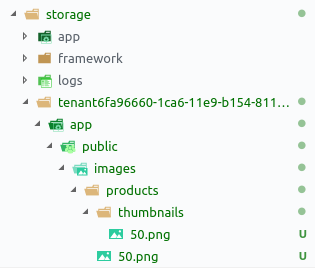Filesystem Tenancy
Note: It's important to differentiate between storage_path() and the Storage facade. The Storage facade is what you use to put files into storage, i.e.
Storage::disk('local')->put().storage_path()is used to get the path to the storage directory.
The storage_path() will be suffixed with a directory named config('tenancy.filesystem.suffix_base') . $id.
The root of each disk listed in tenancy.filesystem.disks will be suffixed with config('tenancy.filesystem.suffix_base') . $id.
However, this alone would cause unwanted behavior. It would work for S3 and similar disks, but for local disks Laravel does its own suffixing. For local storage we need the second of these examples:
/path_to_your_application/storage/app/tenant1e22e620-1cb8-11e9-93b6-8d1b78ac0bcd/
/path_to_your_application/storage/tenant1e22e620-1cb8-11e9-93b6-8d1b78ac0bcd/app/
Why? Because storage_path() returns:
/path_to_your_application/storage/tenant1e22e620-1cb8-11e9-93b6-8d1b78ac0bcd/
so Laravel's storage_path('app') means appending app to that.
That's what the root_override section is for. %storage_path% gets replaced by storage_path() after tenancy has been initialized. The roots of disks listed in the root_override section of the config will be replaced accordingly. All other disks will be simply suffixed with tenancy.filesystem.suffix_base + the tenant id.
Since storage_path() will be suffixed, your folder structure will look like this:

If you write to these directories, you will need to create them after you create the tenant. See the docs for PHP's mkdir.
Logs will be saved to storage/logs regardless of any changes to storage_path(), and regardless of tenant.
Assets
Laravel's asset() helper has two different paths of execution:
- If
config('app.asset_url')has been set, it will simply appendtenant$idto the end of the configured asset URL. This is useful if you use Laravel Vapor. Vapor sets the asset URL to something likehttps://abcdefghijkl.cloudfrount.net/123-456-789. That is the root for your assets. This package will append that with something liketenant1e22e620-1cb8-11e9-93b6-8d1b78ac0bcd. - If
config('app.asset_url')is null, as it is by default, the helper will return a URL (/tenancy/assets/...) to a controller provided by this package. That controller returns a file response fromstorage_path("app/public/$path"). This means that you need to store your assets in the public directory.
Note: In 1.x, the
asset()helper was not tenant-aware, and there was atenant_asset()helper that followed the second option in the list above (a link to a controller). For backwards compatibility, that helper remains intact.If you have some non-tenant-specific assets, you may use the package's
global_asset()helper.
Note that all tenant assets have to be in the app/public/ subdirectory of the tenant's storage directory, as shown in the image above.
This is what the backend of tenant_asset() (and asset() when no asset URL is configured) returns:
// TenantAssetsController
return response()->file(storage_path('app/public/' . $path));
With default filesystem configuration, these two commands are equivalent:
Storage::disk('public')->put($filename, $data);
Storage::disk('local')->put("public/$filename", $data);
Note that every request for a tenant asset requires a full framework boot and tenancy initialization. This is not ideal if you have some assets that occur on each page (like logos). So for non-private assets, you may want to create a disk and use URLs from that disk instead. For example:
Storage::disk('app-public')->url('tenants/logos/' . tenant()->id . '.png');
If you want to store something globally, simply create a new disk and don't add it to the tenancy.filesystem.disks config.
